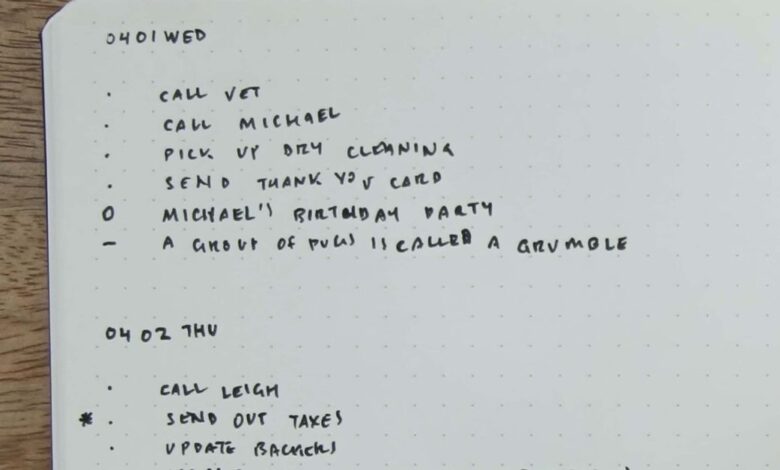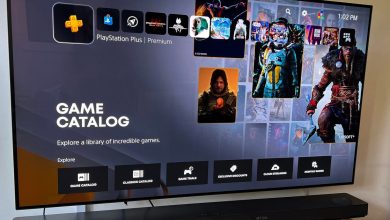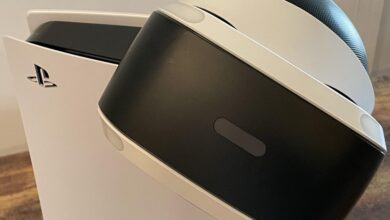What keeping a bullet journal can teach you about using to-do list apps

[ad_1]
On July 6th of this year, I officially ended my three-year-long experiment with trying to organize my life using a physical bullet journal. I know the exact date because I’m looking at my discontinued notebook as I write this. Apparently, five months ago, I needed to take photos of the Corsair K70 keyboard for a then-forthcoming review and follow up with a quote I’d received to insulate my roof. I took the photos. I did not end up insulating my roof.
Since then, I’ve used the notebook for jotting down things to remember here and there, but when it comes to keeping track of daily tasks and chores, I’ve switched back to the same hodgepodge of different note-taking and to-do list apps that I used three years ago. These include Notion for longform notes and lists, Apple Notes when I need something instantly, and Todoist for to-do lists and reminders. But although I’ve ditched the physical notebook for apps, I don’t think bullet journals are a waste of time. In fact, I think my experiment taught me an important lesson about how to stay organized digitally.
Bullet journals can be either physical or virtual (such as with this Notion template), but they’re best known as a way to organize a blank notebook into a personal planner. There are page formats for your yearly, monthly, and daily tasks, a methodology for weaving your to-do list between them, and a series of common symbols and notation to make sense of it all. Ultimately, it’s all in service of giving you a format to design your own planner and flexible rules for how to use it.
There’s a lot of potential complexity, and people like to lay them out in different ways, but my basic approach each day was to write out my list of tasks, manually copy over anything incomplete from previous days (aka “migrate” them), and tick each task off as the day progressed. Some people like to copy over tasks on a weekly or basis, but daily was what worked for me.
The bullet journal’s core is practical, but I was also drawn in by the aesthetics. YouTube is filled with videos of people painstakingly laying them out, filling them with delicate illustrations and little visual elements they slowly fill up over the course of the year. I dreamed of having a small notebook filled with neat handwriting and maybe a sketch or two, like the ones Naughty Dog has its protagonists carry in its games. I imagined my bullet journal as being as much of a scrapbook of my daily life as it was an organizer.
The reality of my truly terrible handwriting meant this never really came to pass, but that didn’t stop my notebook from becoming a half-decent planner. Important emails got jotted down rather than being marked as unread, upcoming articles got categorized with deadlines and priority levels, and I assigned apartment chores to myself on a regular schedule rather than a chaotic ad hoc basis.
But most important was that all of this was being done manually, rather than having an app’s internal logic whisk tasks to and fro. Every morning, I’d be forced to spend a couple of minutes writing out and prioritizing the day’s tasks — and reckoning with what I’d failed to do yesterday. You’d be amazed at how quickly you get around to doing a nonurgent task after forcing yourself to write it out every day for a week. Other times, I realized something that seemed super urgent when I first wrote it down wasn’t worth going through with when I looked back at it the following day.
Having to write each task out manually turned a to-do from something I could just file away in an app and forget about into something that I had to manage on a daily basis. I had to actively prune and prioritize and think about those chores that past Jon had lumbered present Jon with. Did I really need to buy a replacement pair of suit trousers with no formal events on the immediate horizon? And isn’t it time I let that terrible blog post idea go? In each case, forcing myself to just think about what was on my list inevitably kept it more manageable.
Having to carry around a physical notebook sucks
It wasn’t that I grew tired of the writing, but eventually, I got sick of having to carry around a physical notebook. A friend would remind me about a film I wanted to watch while we were in the pub, and I’d have to note it down in a notes app before transcribing it into my physical notebook later. Or I’d be passing a grocery store on the way home and not have my physical shopping list with me. Eventually, the allure of keeping things digital on my phone and with me at all times grew too strong.
What I’ve since realized, however, is that it’s perfectly possible to keep lots of the things I liked about keeping a bullet journal without sacrificing the convenience of apps. Ultimately, what I liked about the notebook was less about its physicality and more about the fact that it forced me to spend real time actively thinking about and organizing my life on a daily basis. And that’s something that’s just as possible to do with an app as it is with a notebook. You just have to avoid thinking the technology can organize it for you.
Now, instead of spending time writing out tasks each day, I instead take a spin through Todoist, pruning out old tasks, changing due dates on others, and generally trying to keep things neat. I don’t have to fight against my terrible handwriting, and I always have my phone on me when I need to jot something down for later. I can still benefit from the streamlined interface, but rather than filing and forgetting a task, I force myself to keep track of it.
And although I don’t think I’ll ever find an app as aesthetically pleasing as a YouTuber’s bullet journal, that doesn’t mean I have to give up on nice designs entirely. I like the options Notion has here, allowing you to customize pages with elements like cover photos and emoji. It’s enough to encourage me to start thinking of it as an ever-evolving scrapbook rather than a utilitarian collection of documents.
It’s easy to think that an app or to-do list service will take you by the hand and organize your life for you, but if you’re not careful, it can just become an infinite digital locker with a messy collection of notes filed under “forget.”
I’m still tempted to give physical journaling another go at some point, especially after scanning through a couple of beautiful bullet journal illustrations in the process of writing this piece. But for now, I’m happy enough to be back on the apps. They’re far from the perfect solution, but I’ve learned that you get as much out of them as you’re prepared to put in.
[ad_2]
Source link






